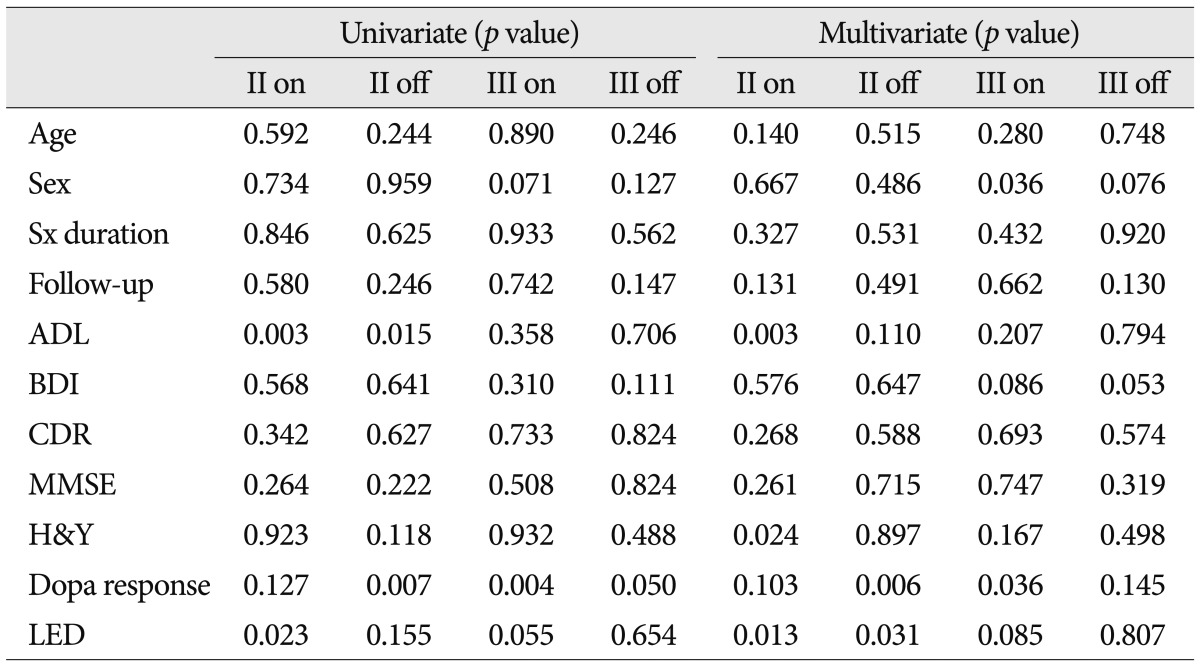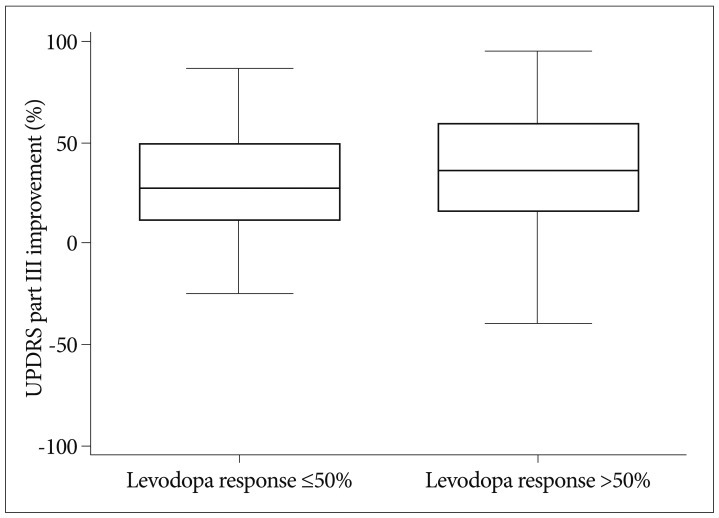1. Accolla E, Caputo E, Cogiamanian F, Tamma F, Mrakic-Sposta S, Marceglia S, et al. Gender differences in patients with Parkinson's disease treated with subthalamic deep brain stimulation. Mov Disord. 2007; 22:1150–1156. PMID:
17469208.

2. Bejjani BP, Gervais D, Arnulf I, Papadopoulos S, Demeret S, Bonnet AM, et al. Axial parkinsonian symptoms can be improved : the role of levodopa and bilateral subthalamic stimulation. J Neurol Neurosurg Psychiatry. 2000; 68:595–600. PMID:
10766889.

3. Benabid AL, Chabardes S, Mitrofanis J, Pollak P. Deep brain stimulation of the subthalamic nucleus for the treatment of Parkinson's disease. Lancet Neurol. 2009; 8:67–81. PMID:
19081516.

4. Cenci MA, Lindgren HS. Advances in understanding L-DOPA-induced dyskinesia. Curr Opin Neurobiol. 2007; 17:665–671. PMID:
18308560.

5. Chang WS, Kim HY, Kim JP, Park YS, Chung SS, Chang JW. Bilateral subthalamic deep brain stimulation using single track microelectrode recording. Acta Neurochir (Wien). 2011; 153:1087–1095. PMID:
21311918.

6. Derost PP, Ouchchane L, Morand D, Ulla M, Llorca PM, Barget M, et al. Is DBS-STN appropriate to treat severe Parkinson disease in an elderly population? Neurology. 2007; 68:1345–1355. PMID:
17452578.

7. Deuschl G, Schade-Brittinger C, Krack P, Volkmann J, Schäfer H, Bötzel K, et al. A randomized trial of deep-brain stimulation for Parkinson's disease. N Engl J Med. 2006; 355:896–908. PMID:
16943402.

8. Erola T, Heikkinen ER, Haapaniemi T, Tuominen J, Juolasmaa A, Myllylä VV. Efficacy of bilateral subthalamic nucleus (STN) stimulation in Parkinson's disease. Acta Neurochir (Wien). 2006; 148:389–394. PMID:
16284705.

9. Erola T, Karinen P, Heikkinen E, Tuominen J, Haapaniemi T, Koivukangas J, et al. Bilateral subthalamic nucleus stimulation improves health-related quality of life in Parkinsonian patients. Parkinsonism Relat Disord. 2005; 11:89–94. PMID:
15734666.

10. Follett KA. Comparison of pallidal and subthalamic deep brain stimulation for the treatment of levodopa-induced dyskinesias. Neurosurg Focus. 2004; 17:E3. PMID:
15264772.

11. Gervais-Bernard H, Xie-Brustolin J, Mertens P, Polo G, Klinger H, Adamec D, et al. Bilateral subthalamic nucleus stimulation in advanced Parkinson's disease : five year follow-up. J Neurol. 2009; 256:225–233. PMID:
19242649.

12. Guehl D, Cuny E, Benazzouz A, Rougier A, Tison F, Machado S, et al. Side-effects of subthalamic stimulation in Parkinson's disease : clinical evolution and predictive factors. Eur J Neurol. 2006; 13:963–971. PMID:
16930362.

13. Hariz GM, Lindberg M, Hariz MI, Bergenheim AT. Gender differences in disability and health-related quality of life in patients with Parkinson's disease treated with stereotactic surgery. Acta Neurol Scand. 2003; 108:28–37. PMID:
12807390.

14. Jankovic J. Motor fluctuations and dyskinesias in Parkinson's disease : clinical manifestations. Mov Disord. 2005; 20(Suppl 11):S11–S16. PMID:
15822109.
15. Kaiser I, Kryspin-Exner I, Brücke T, Volc D, Alesch F. Long-term effects of STN DBS on mood : psychosocial profiles remain stable in a 3-year follow-up. BMC Neurol. 2008; 8:43. PMID:
19014430.
16. Kleiner-Fisman G, Fisman DN, Sime E, Saint-Cyr JA, Lozano AM, Lang AE. Long-term follow up of bilateral deep brain stimulation of the subthalamic nucleus in patients with advanced Parkinson disease. J Neurosurg. 2003; 99:489–495. PMID:
12959435.

17. Kleiner-Fisman G, Herzog J, Fisman DN, Tamma F, Lyons KE, Pahwa R, et al. Subthalamic nucleus deep brain stimulation : summary and meta-analysis of outcomes. Mov Disord. 2006; 21(Suppl 14):S290–S304. PMID:
16892449.
18. Krack P, Batir A, Van Blercom N, Chabardes S, Fraix V, Ardouin C, et al. Five-year follow-up of bilateral stimulation of the subthalamic nucleus in advanced Parkinson's disease. N Engl J Med. 2003; 349:1925–1934. PMID:
14614167.

19. Marceglia S, Mrakic-Sposta S, Foffani G, Cogiamanian F, Caputo E, Egidi M, et al. Gender-related differences in the human subthalamic area : a local field potential study. Eur J Neurosci. 2006; 24:3213–3222. PMID:
17156382.

20. Ory-Magne F, Brefel-Courbon C, Simonetta-Moreau M, Fabre N, Lotterie JA, Chaynes P, et al. Does ageing influence deep brain stimulation outcomes in Parkinson's disease? Mov Disord. 2007; 22:1457–1463. PMID:
17516457.

21. Paek SH, Lee JY, Kim HJ, Kang D, Lim YH, Kim MR, et al. Electrode position and the clinical outcome after bilateral subthalamic nucleus stimulation. J Korean Med Sci. 2011; 26:1344–1355. PMID:
22022189.

22. Paek SH, Yun JY, Song SW, Kim IK, Hwang JH, Kim JW, et al. The clinical impact of precise electrode positioning in STN DBS on three-year outcomes. J Neurol Sci. 2013; 327:25–31. PMID:
23465484.

23. Rodriguez-Oroz MC, Obeso JA, Lang AE, Houeto JL, Pollak P, Rehncrona S, et al. Bilateral deep brain stimulation in Parkinson's disease : a multicentre study with 4 years follow-up. Brain. 2005; 128(Pt 10):2240–2249. PMID:
15975946.

24. Romito LM, Contarino FM, Albanese A. Transient gender-related effects in Parkinson's disease patients with subthalamic stimulation. J Neurol. 2010; 257:603–608. PMID:
19921302.

25. Romito LM, Scerrati M, Contarino MF, Iacoangeli M, Bentivoglio AR, Albanese A. Bilateral high frequency subthalamic stimulation in Parkinson's disease : long-term neurological follow-up. J Neurosurg Sci. 2003; 47:119–128. PMID:
14618124.
26. Schrag A, Quinn N. Dyskinesias and motor fluctuations in Parkinson's disease. A community-based study. Brain. 2000; 123(Pt 11):2297–2305. PMID:
11050029.
27. Schüpbach WM, Chastan N, Welter ML, Houeto JL, Mesnage V, Bonnet AM, et al. Stimulation of the subthalamic nucleus in Parkinson's disease : a 5 year follow up. J Neurol Neurosurg Psychiatry. 2005; 76:1640–1644. PMID:
16291886.
28. Shapiro MB, Vaillancourt DE, Sturman MM, Metman LV, Bakay RA, Corcos DM. Effects of STN DBS on rigidity in Parkinson's disease. IEEE Trans Neural Syst Rehabil Eng. 2007; 15:173–181. PMID:
17601186.

29. Simonin C, Tir M, Devos D, Kreisler A, Dujardin K, Salleron J, et al. Reduced levodopa-induced complications after 5 years of subthalamic stimulation in Parkinson's disease : a second honeymoon. J Neurol. 2009; 256:1736–1741. PMID:
19536584.

30. Simuni T, Jaggi JL, Mulholland H, Hurtig HI, Colcher A, Siderowf AD, et al. Bilateral stimulation of the subthalamic nucleus in patients with Parkinson disease : a study of efficacy and safety. J Neurosurg. 2002; 96:666–672. PMID:
11990805.

31. Tagliati M, Miravite J, Koss A, Shils J, Alterman RL. Is advanced age a poor predictor of motor outcome for subthalamic DBS in parkinson's disease? Neurology. 2004; 62(Suppl 5):A395–A396.
32. Tsai ST, Lin SH, Chou YC, Pan YH, Hung HY, Li CW, et al. Prognostic factors of subthalamic stimulation in Parkinson's disease : a comparative study between short- and long-term effects. Stereotact Funct Neurosurg. 2009; 87:241–248. PMID:
19556833.

33. Tsai ST, Lin SH, Lin SZ, Chen JY, Lee CW, Chen SY. Neuropsychological effects after chronic subthalamic stimulation and the topography of the nucleus in Parkinson's disease. Neurosurgery. 2007; 61:E1024–E1029. discussion E1029-E1030. PMID:
18091257.

34. Weaver FM, Follett K, Stern M, Hur K, Harris C, Marks WJ Jr, et al. Bilateral deep brain stimulation vs best medical therapy for patients with advanced Parkinson disease : a randomized controlled trial. JAMA. 2009; 301:63–73. PMID:
19126811.

35. Welter ML, Houeto JL, Tezenas du Montcel S, Mesnage V, Bonnet AM, Pillon B, et al. Clinical predictive factors of subthalamic stimulation in Parkinson's disease. Brain. 2002; 125(Pt 3):575–583. PMID:
11872614.

36. Wider C, Pollo C, Bloch J, Burkhard PR, Vingerhoets FJ. Long-term outcome of 50 consecutive Parkinson's disease patients treated with subthalamic deep brain stimulation. Parkinsonism Relat Disord. 2008; 14:114–119. PMID:
17822940.

37. Zibetti M, Pesare M, Cinquepalmi A, Rosso M, Bergamasco B, Ducati A, et al. Antiparkinsonian therapy modifications in PD patients after STN DBS : a retrospective observational analysis. Parkinsonism Relat Disord. 2008; 14:608–612. PMID:
18328768.









 PDF
PDF ePub
ePub Citation
Citation Print
Print





 XML Download
XML Download